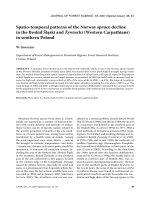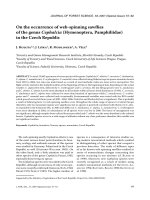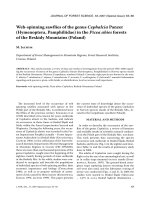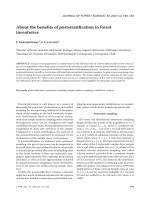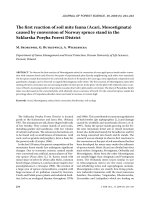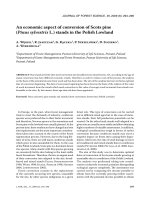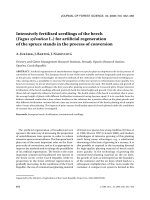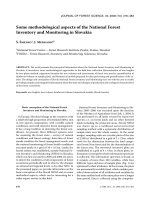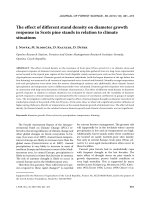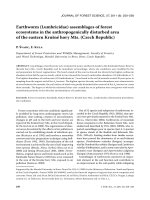Báo cáo lâm nghiệp: "In vitro propagation of Prosopis P. cineraria and P. juliflora) species" potx
Bạn đang xem bản rút gọn của tài liệu. Xem và tải ngay bản đầy đủ của tài liệu tại đây (132.8 KB, 3 trang )
In
vitro
propagation
of
Prosopis
species
(P.
chilensis,
P.
cineraria
and
P.
juliflora)
C.A.
Batchelor
D. Yao,
M.J. Koehler
P.J.C.
Harris
Department
of
Biological
Sciences,
Coventry
Polytechnic,
Priory
Street,
Coventry
CV1
5FB,
U.K.
Introduction
The
genus
Prosopis
has
attracted
con-
siderable
interest
for
forestry
in
arid
areas.
although
normally
propagated
by
seed,
vegetative
propagation
of
selected
Proso-
pis plants
from
variable
populations
and
from
natural
hybrids
may
also
be
desir-
able.
Propagation
by
cuttings
has
been
reported
(e.g.,
Felker
and
Clark,
1981).
).
The
use
of
tissue
culture
techniques
to
regenerate
plants
from
nodal
explants
has
also
been
reported
for
P.
cineraria
(Goyal
and
Arya,
1984),
P.
tamarugo
and
P.
chilensis
(Jordan
and
Balbao,
1985),
and
P,
alba
(Tabone
et al.,
1986).
In
this
study,
tissue
culture
media
were
evaluated
for
root
initiation,
shoot
proliferation
and
shoot
growth
of
P.
chilensis,
P.
cineraria
and
P.
juliflora.
Materials
and
Methods
Explants
with
1
or
2
nodes
were
taken from
the
youngest
6
nodes
of
the
main
stem
and
branches
of
3-12
mo
old,
greenhouse-grown
stock
plants.
Explants
were
surface
sterilized
in
70%
industrial
methylated
spirit
for
1
min
and
5%
(v/v)
sodium
hypochlorite
for
5-10
min,
and
immersed
in
an
anti-oxidant
solution
(100
mg/I
citric
acid,
50
mg/I
ascorbic
acid,
100
mg/I
poly-
vinyl
pyrrolidone)
for
15
min.
Murashige
and
Skoog
medium
was
used
with
8
g/I
agar,
30
g/I
sucrose,
1.6
g/l
glutamine
and
81
combinations
of
plant
hormones,
including
kinetin
(K)
(0.05-15
mgA),
benzylamino
purine
(BA)
(0.05-15
mg/I),
indole
acetic
acid
(IAA)
(1-10
mg/I),
indole
butyric
acid
(IBA)
(1-15
mg/I)
and
naphthalene
acetic
acid
(NAA)
(1-15
mg/I).
Between
4
and
16
explants
were
placed
on
each
medium
and
incubated
at
25°C
with
a
16
h
pho’toperiod
and
a
photon
flux
den-
sity
of
65-200
!E/m2
for
51
d.
Results
Without
hormones,
results
for
rooting
per-
centage,
mean
number
of
shoots/explant
node
and
mean
number
of
nodes/regen-
erated
shoot
were,
P.
chilensis,
0%,
0.8,
1.2,
P.
cineraria,
13%,
0.8,
1.0,
and
P.
juli-
flora,
6%,
0.4,
1.0.
A
summary
of
the
most
successful
hormone
treatments
is
given
in
Table
I.
High
levels
of
BA
induced
shoot
proliferation
of
P.
chilensis
with
15
mg/l
BA,
5
mg/l
NAA
giving
the
highest
mean
of
4.3
shoots/node.
Similar
levels
of
K
were
much
less
effective
for
shoot
prolif-
eration.
Shoot
growth
of
P.
chilensis
was
greatest
(5
nodes/shoot)
with
0.05
mg/I
K,
3
mg/I
IBA.
0.05
mg/I
BA
with
3
mg/I
IBA,
or
0.05
or
1
mg/I
K,
with
3
or
15
mg/I
IBA
induced
rooting.
0.05
mg/I
K,
3
mg/I
IBA
gave
the
greatest
number
(2.5)
of
roots/explant
and
1
mg/I
K,
15
mg/I
IBA
the
greatest
(75%)
percentage
of
rooted
explants.
Shoot
proliferation
of
P.
cineraria
was
also
promoted
by
high
levels
of
BA,
10
mg/I
BA,
5
mg/I
NAA
resulting
in
3
shoots/node.
K
failed
to
induce
multiple
shoot
production
in
P.
cineraria.
Shoot
growth
was
greatest
(3
nodes/shoot)
with
3
mg/I
K,
23
mg/l
NAA
but
1
mg/I
BA,
3
mg/I
IBA
gave
reduced
leaf
abscission.
Rooting
of
P.
cineraria
was
obtained
only
with
combinations
of
K
and
IBA
(0.05
mg/I
K,
1-15
mg/I
IBA,
and
1
mg/I
K,
15
mg/I
IBA),
the
greatest
number
of
roots
(2.8/
explant)
being
initiated
with
1
mg/l
K,
15
mg/I
IBA
and
the
highest
rooting
per-
centage
(75%)
being
with
0.05
mg/I
K,
15
mg/I
IBA.
Results
for
P.
juliflora
were
less
conclu-
sive.
In
very
few
cases
were
multiple
shoots
obtained
and
no
treatment
gave
a
mean
of
>1.5
shoots/node.
Shoot
growth
of
P.
juliflora
was
greatest
(3
nodes/shoot)
with
0.05
mg/I
K,
15
mg/I
IBA.
10
mg/I
K,
1
mg/I
IAA
gave
the
greatest
leaf
reten-
tion.
Root
initiation
by
P.
juliflora
was
most
successful
with
K
in
combination
with
IBA.
0.05
mg/I
K,
15
mg/I
IBA
was
the
best
treatment
(75%
rooted
explants,
5.6
roots/explant).
Rooted
plantlets
of
each
species
were
transferred
to
compost
in
a
greenhouse
with
100%
survival
after
3
months.
Discussion
and
Conclusion
The
relative
ease
of
micropropagation
in
this
study
was
P.
chilensis
>
P.
cineraria >
P.
juliflora.
The
results
for
all
3
species
show
a
similar
pattern.
In
general,
IBA
promotes
rooting
and
K
is
less
inhibitory
to
root
production
than
is
BA.
High
concen-
trations
of
BA,
but
not
of
K
in
combination
with
auxins,
promote
shoot
proliferation
probably
by
stimulating
axillary
bud
growth.
Medium
to
high
concentrations
of
auxin
in
combination
with
low
to
medium
cytokinin
concentrations
promote
shoot
growth.
The
results
for
R
chilensis
and
P.
cineraria
provide
the
basis
for
a
possible
micropropagation
system
consisting
of
shoot
proliferation,
shoot
growth
and
root-
ing
stages,
an!!
this
system
is
being
eva-
luated.
Further
work
with
P.
juliflora
is
required
to
optimize
culture
conditions
for
each
stage.
Acknowledgmients
This
research
was
funded
by
the
Henry
Double-
day
Research
Association.
References
Felker
P.
&
Clark
P.R.
(1981)
Rooting
of
mes-
quite
(Prosopis)
cuttings.
J.
Range
Manage.
34,
466-468
Goyal
Y.
&
Arya
H.C.
(1984)
Tissue
culture
of
desert
trees:
1.
Clonal
multiplication
of
Proso-
pis
cineraria
by
bud
culture.
J.
Plant
Physiol.
115, 183-189
Jordan
M.
&
Balbao
O.
(1985)
In
vitro
regenera-
tion
of
Prosopis
tamarugo
Phil.
and
Prosopis
chilensis
(Mol.)
Stuntz
from
nodal
sections.
Gartenbauwisse.nchaft 50, 138-142
Tabone
T.J.,
Felker
P.,
Bingham
R.L.,
Reyes
I.
&
Loughrey
S.
(1986)
Techniques
in
the
shoot
multiplication
of
the
leguminous
tree
Prosopis
alba
clone
B2V
50
.
For.
Ecol.
Manage.
16,
191-
200
